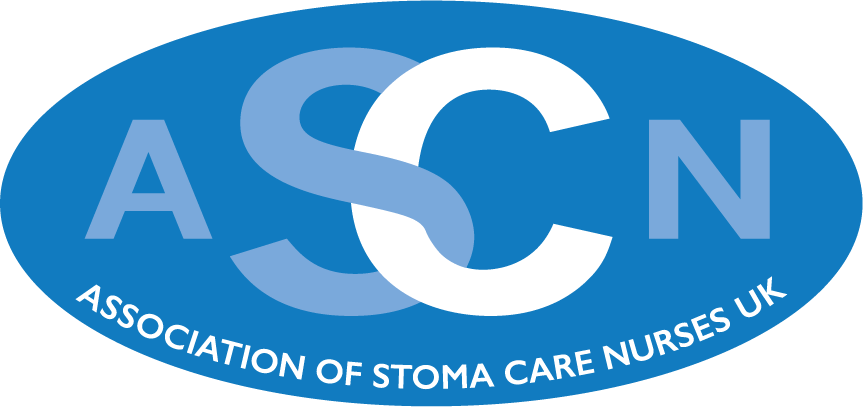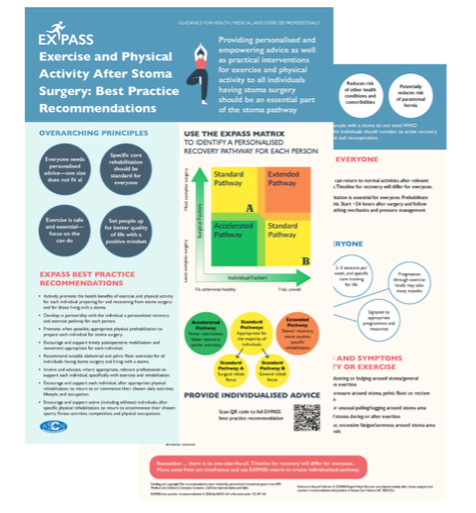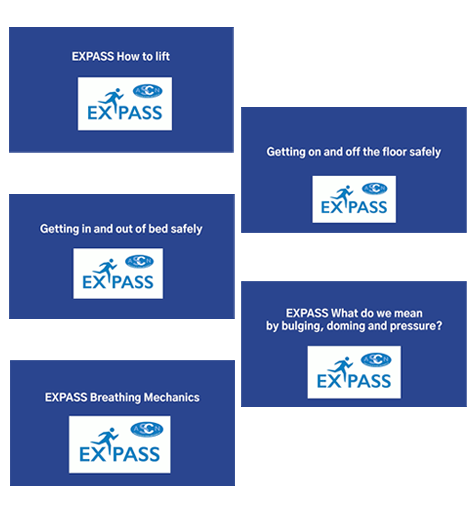EXPASS Best Practice Recommendations
ASCN UK is proud to present the EXPASS Best Practice Recommendations – Exercise and Physical Activity after Stoma Surgery. Date of publication October 2025.
These recommendations aim to provide guidance about exercise and rehabilitation for all health, exercise and medical professionals caring for and supporting individuals having stoma surgery. People living with a stoma or undergoing surgery themselves are also welcome to download and read them.
Please note: updated edits to the recommendations will be published in January 2026, along with further matrix reference guides. We recommend waiting to print the full recommendations document until this update is available. One key amendment relates to alignment of the core exercise recommendations on page 22: The correct recommendation is that individuals can commence level 1 core exercises and breathing practice from 24 hours post-surgery where possible, and not 3-4 days as stated.
These recommendations have been designed to fundamentally improve outcomes for your patients as well as support you in your practice with a high-quality, evidence-based resource.
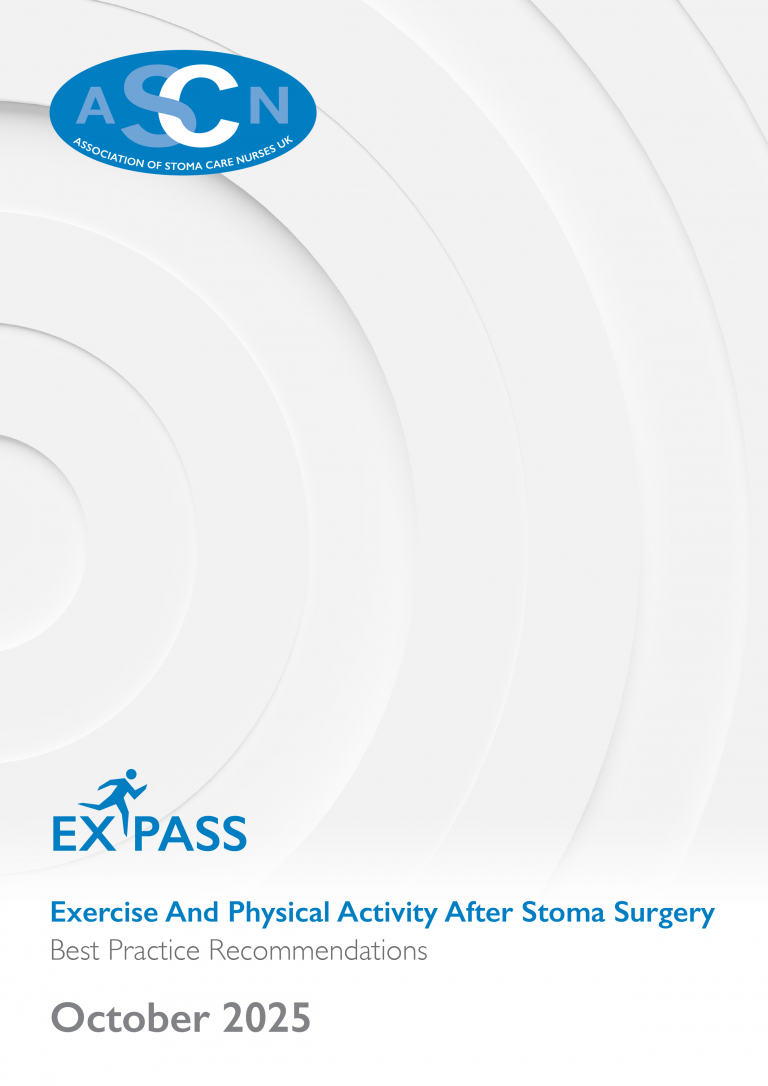
Best Practice Recommendations
An Expert Panel of fifteen multi-disciplinary professionals developed the EXPASS recommendations over a 2-year period (following an extensive literature review) achieving 100% agreement on the content of the key 8 recommendations, before peer review and ASCN UK committee approval.
The recommendations have been formally endorsed by the Association of Coloproctology Nurses of Great Britain and Ireland, Nurses Specialized in Wound, Ostomy and Continence Canada (NSWOCC®), and Wound Council of Enterostomal Therapist (WCET®) Executive Board.
This 2-page quick reference guide captures the essence of the recommendations to enable professionals to scan key aspects of the framework and explain it to individuals.
It should be read and used in conjunction with full document.
This video series supports the recommendations and are aimed at exercise, health care, or medical professionals to explain some of the key concepts.
They should be viewed in conjunction with the full recommendations document.
About the EXPASS Recommendations
The gaps in knowledge and lack of standardisation in care is stark and concerning. The advice and support provided to individuals is often contradictory and confusing. Individuals are often left feeling disabled by their stoma and unable to return to work or the activities they enjoy. Research has shown that the vast majority of people living with a stoma do not do enough physical activity for their health. Current advice on exercise after stoma surgery is contradictory, often restrictive, overly cautious, and with no agreed consensus. It is the aim of this document to challenge the dogma that exercise is somehow dangerous or risky; to consider the importance of the wider health and well-being of the individual, not just the stoma or risk of hernia; and to position exercise and physical activity as a positive and essential part of life. Our hope is that these recommendations start to change these worrying trends. With careful consideration and consultation with professionals and people with lived experience, these EXPASS recommendations have taken a number of years to develop. The EXPASS Expert Panel has worked under the supervision of ASCN UK.
Clinical practice is becoming more established in the area of exercise and rehabilitation, and despite the lack of published research, there is sufficient knowledge and experience currently available to develop best practice recommendations. They are evidence-informed and incorporate the most up-to-date methods and thinking drawn from current clinical practice and other areas of medicine and exercise science. Making a complex topic simple to understand and implement has not been easy, and that has been the key challenge we have faced. Individuals have stoma surgery for a wide range of medical conditions; therefore, the stoma is simply the outcome, not the condition. The recommendations aim to address these individual differences, and we have attempted to simplify a range of complex and varied factors.
Who Are They For?
This document is aimed at any professional caring for or working with adults (> 16 years) having stoma surgery or living with a stoma. Individuals having stoma surgery themselves are also welcome to refer to these recommendations. The recommendations focus both on those having an initial formation of a urostomy, ileostomy, or colostomy for any reason and on specific recommendations related to exercise and physical activity. These recommendations do not specifically cover parastomal hernia repair or stoma reversal, but they do consider exercising with a parastomal hernia. The information, however, is still likely to be relevant and appropriate.
Why Are They Needed?
Formal published recommendations related to exercise, physical activity, and stoma surgery do not currently exist. The EXPASS recommendations aim to address this significant gap. Surgery to create a stoma impacts as many as 13,500 people each year in the UK, and it is thought that around 1 in 350 people live with a stoma (Kettle, 2019). The causes of stoma formation are varied and, in some cases, can result in complex life-changing surgery. Some physical rehabilitation following stoma surgery is generally considered an important process in enabling a return to activities of daily living, school or work, and exercise (Asnong et al., 2021). Low levels of physical activity are prevalent in individuals living with stomas, and the negative implications of inactivity are significant in terms of incomplete recovery, comorbidities, poor quality of life, and reduced health span.
There is a significant gap in the knowledge base of professionals, and the advice for individuals having stoma-forming surgery (specifically around exercise, physical activity, and rehabilitation) is poor, confusing, and inconsistent. Professionals need to be able to support individuals having surgery with better advice and guidance, and individuals should be able to access trusted, well-informed information. Individuals want to know what they can do to optimise their recovery, exercise safely, reduce their chance of hernia, and return to the activities and lifestyle they enjoy. Available advice about exercise (accessed online or provided by professionals) is contradictory and confusing, and there is no national nor global standardisation. Advice given is often based on personal experience and the bias of professionals, and dogma is deeply entrenched in clinical practice.
While these recommendations are aimed at individuals having initial stoma formation or those already living with a stoma, the general advice is still very relevant and appropriate for individuals having hernia repair or stoma reversal.
What Are the Aims?
The EXPASS best practice recommendations have multiple aims:
- Professionals will feel more confident (specifically related to exercise and physical activity) when supporting individuals having surgery with appropriate advice about preparing for and recovering from surgery as well as living with a stoma long term.
- Individuals will have less fear avoidance and will feel more confident about engaging safely in appropriate physical activity, occupations, and exercise.
- While the recommendations do not focus specifically on parastomal hernia prevention or management, it is likely that appropriate rehabilitation and exercise may reduce the risk of parastomal hernia and help to manage existing herniation.
- Individuals will be able to consider how to optimise their recovery, exercise safely, and get back to the activities, occupations, and lifestyle that are important to them.
- Increased levels of appropriate physical activity will lead to better general health outcomes for individuals, with fewer comorbidities and increased quality of life.
- A reduction of the burden of cost for the National Health Service (NHS) and wider economy in relation to the NHS plan 2025 (NHS, 2025). These are related to improved health, reduced comorbidities and reduced risk of hernia. Economic considerations for the wider society include returning to work and contributing to the economy.
Quick Reference Guide
A standalone EXPASS quick reference guide is included to enable professionals to scan key aspects of the framework and explain it to individuals.
Common FAQs From Individuals With Stomas
The recommendations will address these common frequently asked questions (FAQs) specifically about exercise and physical activity:
- What can I do?
- When can I do it?
- How can I best prepare for surgery?
- How can I best recover?
- Is there anything I need to avoid?
- How can I reduce my risk of hernia?
Refer to the helpful narrative answers to these FAQs in section ‘Common FAQs From Individuals With Stomas‘.
The EXPASS Expert Panel
EXPASS Project Lead:
- Sarah Russell, MSc, BSC, RCCP, PWLLE
EXPASS Principal Authors:
- Sarah Russell, MSc, BSC, RCCP, PWLLE
- Kerry Archer, MSc, MCSP
Contact information:
- Sarah Russell: sarah@sarah-russell.co.uk
- Kerry Archer: kerryjarcher@googlemail.com
- ASCN UK: admin@ascnuk.org
Expert Panel:
- Sanjay Chaudhri, MS, FRCS
- Gráinne M. Donnelly, MSc, BSc(Hons), PgCert, POGP
- Gill Hubbard, PhD, MSc, BA(Hons), PGCE
- Faye Jones, MSc, BSc
- Isabel S. Moore, PhD, BSc(Hons), FHEA
- Yvonne Morris, PWLLE
- Raymond Oliphant, MD, BMedSci(Hons), FRCSEd, MFSTEd
- Wendy Osborne, MSc, RGN
- Ryan Owens, PWLLE
- Caroline Rudoni, BSc, RGN
- Chris Ryder, MBA, PWLLE
- Gabrielle Thorpe, PhD, MSc, MA, RN, SFHEA
- Maddie White, MSc, BSc, RN
Note. PWLLE = people with lived or living experience.
Endorsed by
The recommendations have been endorsed by the following professional bodies:
- Association of Chartered Physiotherapist in Oncology and Palliative Care (ACPOPC)
- Pelvic, Obstetric and Gynaecological Physiotherapy (POPG)
- Chartered Society of Physiotherapists (CSP)
- World Council of Enterostomal Therapists (WCET)
- Nurses Specialized in Wound, Ostomy and Continence Canada (NSWOCC)
- Association of Coloproctology Nurses of Great Britain & Ireland (ACPN)
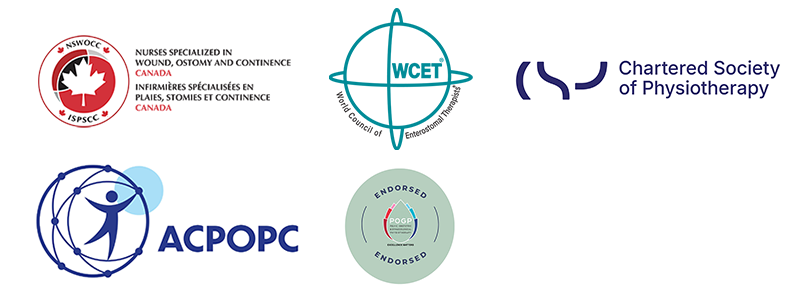
Acknowledgments
The recommendations were funded by unrestricted educational grants from AMI Medical Ltd, Clinimed, Coloplast, Convatec, CUI International, Eakin Healthcare, and Salts Healthcare.

Technical writer and project manager John Gregory, IIWCC, ISWA, Opencity Inc., and team, edited and produced these recommendations in collaboration with the EXPASS Expert Panel.
Further Information
Suggested Citation
To reference this guide, use the following suggested citation:
Russell S, Archer K, EXPASS Expert Panel. Exercise and physical activity after stoma surgery: best practice recommendations. Association of Stoma Care Nurses UK. 2025 Oct. Available from: https://ascnuk.org/
Open Access
This document is licensed under a Creative Commons Attribution 4.0 International License, which permits use, sharing, adaptation, distribution and reproduction in any medium or format, as long as you give appropriatecredit to ASCN (UK) and the source, provide a link to the Creative Commons licence, and indicate if changeswere made. The license allows for commercial use. The images or other third-party material in this article are included in the document’s Creative Commons licence, unless indicated otherwise in a credit line to the material. If material is not included in the article’s Creative Commons licence and your intended use is not permitted by statutory regulation or exceeds the permitted use, you will need to obtain permission directly fromthe copyright holder (ASCN UK). EXPASS best practice recommendations © 2025 by ASCN UK is licensed under CC BY 4.0. To view a copy of this license, visit https://creativecommons.org/licenses/by/4.0/
Disclaimer
These recommendations are not binding on nurses or the organisations that employ them. The application of these recommendations should be based on individual needs and local circumstances. They neither constitute a liability nor a discharge from liability. While every effort has been made to ensure the accuracy of the contents at the time of publication, neither Association of Stoma Care Nurses UK (ASCN UK) nor the EXPASS Expert Panel offers any guarantee as to the accuracy of the information contained in them nor accept any liability with respect to loss, damage, injury, or expense arising from any error or omission in the contents of this work. References to products and educational programs within this document do not constitute an endorsement of these products and programs. It is the responsibility of the individual or professional to refer to the most up-to-date version of these recommendations.
QR Code
 Share this QR code with colleagues and individuals to help them access these EXPASS resources, and find out more about the Advancing Stoma Care Services (ASCS) Project.
Share this QR code with colleagues and individuals to help them access these EXPASS resources, and find out more about the Advancing Stoma Care Services (ASCS) Project.
